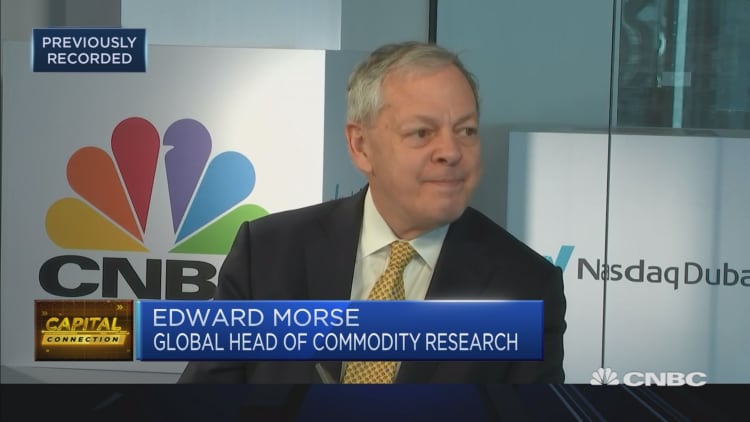
OPEC may not have gone far enough to hoist oil prices through 2019 — and a weak demand outlook could prompt the need for another production cut by the cartel and its allies by spring next year, Citi's top commodities analyst said Wednesday.
"I think they went far enough for the time being," Ed Morse, Citi's global head of commodities research, told CNBC, describing last weekend's OPEC and non-OPEC agreement led by Saudi Arabia and Russia to cut crude output by 1.2 million barrels per day (bpd) by January.
"They're going to have to re-address this issue sometime next year, but I'm glad they're meeting for their sake in April, and it may be by April they're going to have to confront another cut," Morse said of the organization's next summit in Vienna.
When asked about the size of this potential cut, Morse stopped short of making a call, instead pointing to the bigger picture: booming production volumes from the U.S. threatening OPEC's power to shape the oil market.
'The bear, the camel, and the eagle'
"I like to call it the struggle of the bear, the camel and the eagle," Morse said, referring to Russia, Saudi Arabia and the U.S., the world's top three oil producers. "Saudi Arabia discovered that OPEC doesn't have the clout it used to have."
The 15-member cartel has a current output of roughly 35 million bpd. That's just over its late 1970s level of around 30 million bpd, when global oil demand was in the 60 million bpd range, according to the Energy Information Administration (EIA). Global demand is now in the 100 million bpd range.
"So by definition, they lost market clout," Morse said. The recent departure announcement by Qatar, scheduled for January 1, has added further questions as to the future of the group.
[OPEC is] now confronting the result of the higher prices that they've orchestrated, namely this incredible rebound in U.S. production which is overwhelming their efforts to deprive the world of inventory.Ed MorseGlobal head of commodities research, Citi
Moreover, in pushing up prices through previous production cuts, OPEC has inadvertently spurred more investment and production in American shale.
"The more OPEC+ tries to support prices by withholding oil from the market, the more they give the U.S. shale sector an out from rationing supply growth themselves," Citi's December energy and macro outlook said. "In our base OPEC+ cut scenario, global inventories should continue to build to mid-2019 (and beyond in the bear case)."
Essentially, in order to tame U.S. growth, OPEC would need a lower oil price that they don't want.
"They're confronting a much weaker market than they've seen in the past two years when they've drawn down inventories," Morse continued. "Demand is really problematic going forward and they're now confronting the result of the higher prices that they've orchestrated, namely this incredible rebound in U.S. production which is just overwhelming their efforts to deprive the world of inventory."
Darkening demand forecasts
Demand forecasts are weak among a number of market analysts. U.S.-based consultancy Capital Economics expects "a combination of slower global GDP growth and persistent rises in US shale output to lead to lower oil prices in 2019," according to its energy update report published Tuesday. The firm forecasts global benchmark Brent crude at $55 per barrel, down from $60 previously.
Others don't necessarily see such a bearish case. Bank of America Merrill Lynch forecasts Brent at $70 a barrel for 2019, though that's a notch down from its previous forecast of $71. And Japan's MUFG s views Brent and U.S. West Texas Intermediate (WTI) to be "oversold," predicting a "sharp rebound" in coming months.
Bank of America's outlook is underpinned by above trend global gross domestic product growth of 3.6 percent, its analysts say; meanwhile, Goldman Sachs this week warned of a U.S. slowdown to less than 2 percent that would seriously knock growth worldwide.
As of Wednesday 12:30 p.m. London time Brent and U.S. benchmark West Texas Intermediate (WTI) were paring losses from earlier in the week, trading at $61.25 and $52.66, respectively.
The American eagle is 'soaring'
Oil prices have plunged nearly 30 percent since reaching year highs of more than $86 per barrel in early October over concerns of global oversupply and weakening demand. The U.S.-China trade war, political turmoil across European markets and fears of impending slowdown in global economic growth have also seriously clouded the demand outlook.
And the EIA has upgraded its supply growth outlook for American crude. U.S. domestic oil production is now expected to increase by 1.18 million bpd next year, up slightly from November's estimate of 1.16 million bpd, with output averaging 12.06 million bpd, according to PVM Oil Associates.
"This impending flood of fresh U.S. crude supply will cement its newfound position as the world's top oil producer," the oil consultancy said Wednesday.
The Saudis have worked to enlist the support of Russia in their market-shaping endeavors. But while Moscow prefers a lower oil price to Riyadh, the two will have to join forces to deal with the eagle, Morse said.
"The American eagle is just soaring," he said, "and nobody would've predicted that."


